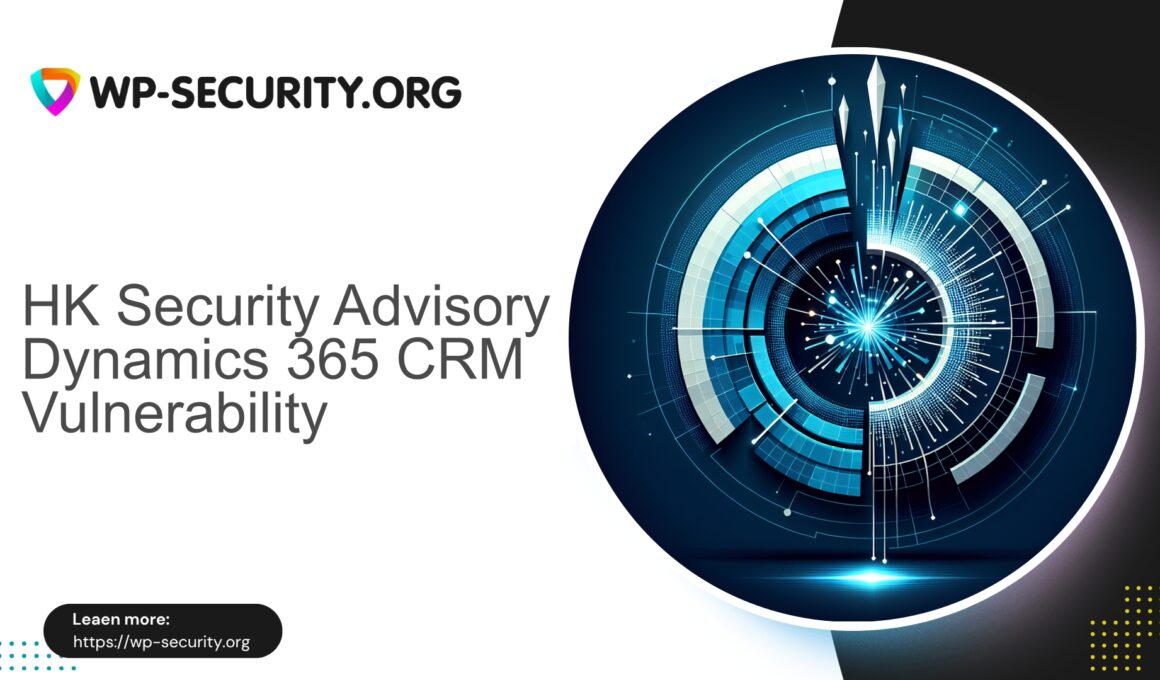| Plugin Name | Integrate Dynamics 365 CRM |
|---|---|
| Type of Vulnerability | Missing Authorization |
| CVE Number | CVE-2025-10746 |
| Urgency | Medium |
| CVE Publish Date | 2025-10-03 |
| Source URL | CVE-2025-10746 |
Security Advisory — Integrate Dynamics 365 CRM: Missing Authorization (CVE-2025-10746)
Published: 2025-10-03 · Author: Hong Kong Security Expert
Executive summary
On 2025-10-03 a CVE was assigned for a missing authorization issue in the WordPress plugin “Integrate Dynamics 365 CRM” (CVE-2025-10746). The vulnerability allows unauthorised users or remote actors to access privileged plugin functionality or endpoints that should be restricted. The weakness is categorised as “Missing Authorization” and has been rated with medium urgency.
Who should care
- Organisations using the Integrate Dynamics 365 CRM plugin on WordPress sites.
- Enterprises in Hong Kong processing personal data via WordPress integrations with Microsoft Dynamics 365.
- Security teams and site administrators responsible for CMS hardening and third‑party integrations.
High-level technical overview
The reported issue is a missing authorization control on one or more plugin endpoints or actions. In practice this means the plugin exposes functionality that should only be callable by authenticated and authorised administrators or service accounts, but does not enforce those checks consistently. Attackers who can reach those endpoints may perform actions or retrieve data beyond the intended permissions of anonymous or low‑privilege users.
Note: this advisory provides a non‑exploitable, high‑level description. It does not include exploit steps or proof‑of‑concept code.
Potential impact
- Unauthorized access to CRM integration operations (data pulls, configuration changes).
- Exposure or leakage of CRM-related data or metadata if endpoints return sensitive content.
- Unauthorised modification of plugin settings which can disrupt data flows to Dynamics 365.
- Reputational and compliance risk for organisations in Hong Kong under data protection obligations.
Detection and indicators
Administrators should look for unusual requests to plugin-related endpoints, especially POST or GET requests that perform configuration or integration actions. Check server logs and web application logs for:
- Requests to known plugin paths originating from unexpected IP ranges.
- Requests that return HTTP 200 or 204 for actions that normally require administrator interaction.
- Spike in requests to endpoints after a public disclosure.
Where possible, enable logging of successful and failed authorization checks for the plugin and centralise logs for review.
Mitigation and recommended actions
As a Hong Kong security practitioner, I recommend a cautious, pragmatic approach:
- Update: If the plugin vendor has released an update that addresses the vulnerability, apply the patch promptly following your change management process.
- Restrict access: Limit access to the plugin endpoints at the network or web server level (for example, restrict by IP, require authentication at the reverse proxy, or limit access to internal networks) until a fixed version is deployed.
- Least privilege: Review user roles and permissions. Ensure that only necessary accounts have administrative rights and that service accounts use the minimum required privileges.
- Disable if unnecessary: If the integration is not critical, consider temporarily deactivating or removing the plugin until a fix is available and validated.
- Monitoring: Increase monitoring of web logs, authentication attempts, and application errors related to the plugin.
- Vendor contact: Open a support ticket with the plugin author for confirmation of the fix and any recommended remediation steps. Retain communication records for compliance review.
Response checklist for Hong Kong organisations
- Identify all WordPress instances using the Integrate Dynamics 365 CRM plugin.
- Confirm plugin version on each instance; prioritise sites handling sensitive or regulated data.
- Apply vendor patches where available; if not, apply temporary controls (access restrictions, deactivation).
- Review logs for suspicious activity and capture any anomalous requests for forensic analysis.
- Inform internal stakeholders (IT, compliance, data protection officer) and, if necessary, follow notification guidance under local data protection rules.
Regulatory and compliance considerations
Organisations in Hong Kong should consider the requirements of the Personal Data (Privacy) Ordinance (PDPO) and internal incident response policies. If personal data exposure is suspected, coordinate with legal and privacy teams to evaluate notification obligations and remediation timelines.
Final notes
This advisory is intended to inform administrators and security teams without providing actionable exploitation details. For the safest outcome, treat public disclosures of missing‑authorization issues as higher risk for sites with sensitive integrations and respond expediently.
If you need a tailored assessment for your environment, consider engaging a professional security assessment service or your internal security team to validate mitigations and patch deployment.
